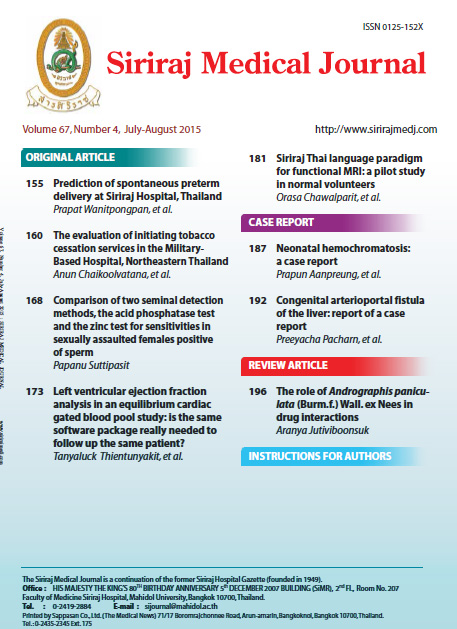Prediction of Spontaneous Preterm Delivery at Siriraj Hospital, Thailand
Abstract
Objective: To assess the significance of various parameters that attribute to preterm delivery before 35 weeks in Thai women with normal singleton pregnancies.
Methods: A cohort analytical study enrolling 1,027 Thai pregnant women was carried out. Those who had risk factors of preterm labour, indicated preterm birth or the cases with fetal anomalies were not included. Nineteen parameters including cervical length at mid-trimester were assessed. The cutoff value for short cervix in this study was defined at less than 30 mm. Univariate and logistic regression analysis were used to determine the significance of each parameter.
Results: From the 19 parameters, logistic regression analysis demonstrated that short cervix is the only parameter that is associated with preterm delivery before 35 weeks (p= 0.019) (OR = 3.77; 1.24-11.49). There is a trend towards significance for history of preterm birth (p= 0.089). Amniocentesis or Cesarean delivery of the mothers had no effect on the incidence of preterm labour in the current pregnancy (p= 0.73 and 0.53 respectively).
Conclusion :For Thai women with normal singleton pregnancies, those who have cervical length measured at mid-trimester less than 30 mm have 3.8 times higher risk of preterm delivery than those who have normal cervical length. Short cervix and history of previous preterm birth should be used as important predictors of preterm labour.
Keywords: Preterm delivery, short cervix, Thai pregnant women
Downloads
Published
How to Cite
Issue
Section
License
Authors who publish with this journal agree to the following conditions:
Copyright Transfer
In submitting a manuscript, the authors acknowledge that the work will become the copyrighted property of Siriraj Medical Journal upon publication.
License
Articles are licensed under a Creative Commons Attribution-NonCommercial-NoDerivatives 4.0 International License (CC BY-NC-ND 4.0). This license allows for the sharing of the work for non-commercial purposes with proper attribution to the authors and the journal. However, it does not permit modifications or the creation of derivative works.
Sharing and Access
Authors are encouraged to share their article on their personal or institutional websites and through other non-commercial platforms. Doing so can increase readership and citations.










